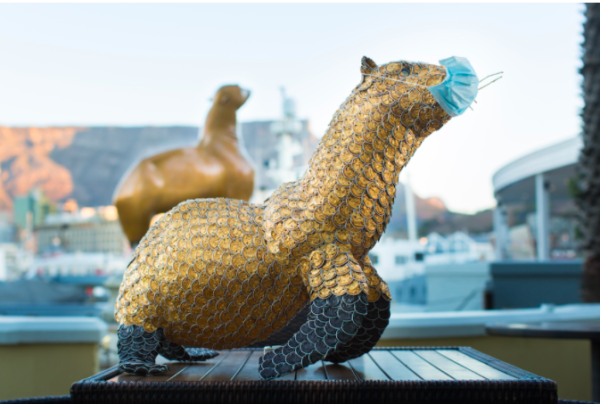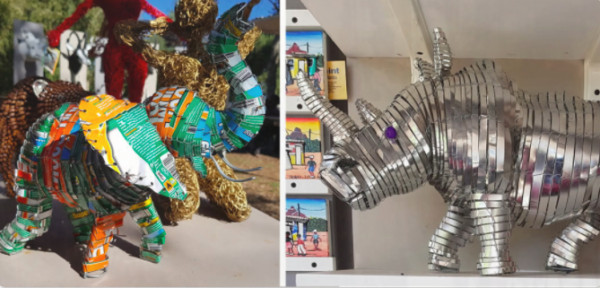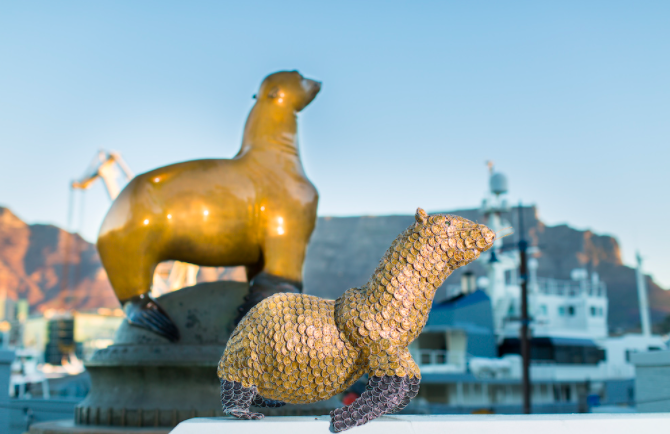Capetonians and coffee are in an inarguable love affair close to the likes of Parisians. However, coffee, or rather coffee capsules have now been reimagined artistically by the brilliant Godfrey Dambuleni. His work shows us the beauty of reusing recycled materials, and his latest sculpture is Oscar the golden seal, the Table Bay Hotel’s mascot.
Godfrey Dambuleni is a sculpture artist whose latest medium is used Nespresso capsules.
Dambuleni has recreated Oscar, who you might recognise as the gorgeous golden seal. Dambuleni was commissioned to make another version of the seal using his coffee powers, and it’s all in line with sustainable strides.

According to Joanne Selby, The Table Bay Hotel’s general manager, The Table Bay is “at the forefront of green consciousness,” Good Things Guy cites. Thus, in striving toward sustainable awareness, the nature of Dambuleni’s work is a perfect fit for their eco-friendly goals.
“I have been using Nespresso capsules for almost five years, making elephants, rhinos, human beings and more,” Dambuleni expressed. “Oscar was the first seal I had ever made and took me about three weeks to make,” as per Map My Way.
The recycled Oscar is a 1.5-metre-high statue, made from 3,000 capsules.
“We partnered with Nespresso on this project as their aluminium capsules used at The Table Bay are infinitely recyclable, and we are excited to give Oscar the Nespresso seal pride of place,” Selby said.
Who is the artist?
Dambuleni is originally a Zimbabwean local who runs a studio in Salt River. His art niché isn’t just coffee capsules, however, but all recycled materials. From recycled tins to bicycle chains, he’s creatively reimagined materials that most people wouldn’t think twice about. He then proceeds to rework and turn them into some of the most captivating pieces.
In an interview with Sue Heathcock, Dambuleni explained how he developed his patchwork style of recycled art.
“I started off doing the weaving method,” Dambuleni explained. “cutting strips of recycled tins and weaving them onto the metal frame. But then when I had colourful tins, you couldn’t really see the prints and patterns. So I started cutting the pieces bigger and patchworking them, using different colours and letting the logos and designs be seen so that they became part of the story.
He also gave the low down on what materials he doesn’t use. Thicker metal tins are a green light, like biscuit tins or doom cans. However modern aluminium drink cans are a no go because the metal is too thin.
His process.

According to Dambuleni, he shapes all the wireframes. His team helps him clean and cut up some of the materials. He arranges the pieces and colours and then wires them all together beautifully. He does the final touches- shaping and finishing and then goes over all the pieces again to make sure there aren’t any sharp edges sticking out. Lastly, he coats the work with a final sealant so that they don’t rust.
In terms of Oscar and the coffee capsules Dambuleni said:
“The aluminium coffee capsules are a very useful material, being soft and malleable they can be used in many ways. Before I can use them, my team cleans the coffee grinds out and flattens them to make small sheets of metal,” Dambuleni portrays. The artist and his team also use the coffee grounds as fertiliser to grow vegetables, “further extending the chain of the circular economy,” as Map My Way puts it.
Picture: The Table Bay Hotel

